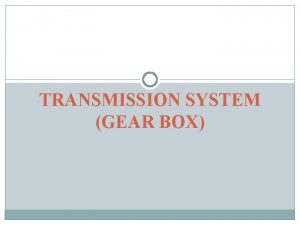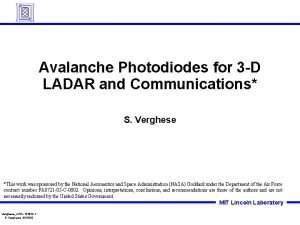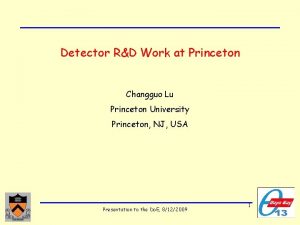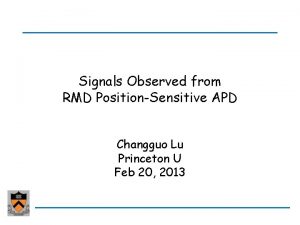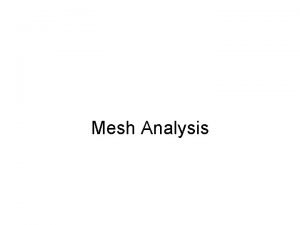SN Issue of Mesh APD Changguo Lu Princeton






- Slides: 6

S/N Issue of Mesh APD Changguo Lu Princeton University 3/2/2016 1

N. Cartiglia, INFN, Torino, 2/15 -19/2016 4 D tracking Noise in LGAD & APD – Aide Memoire According to this argument it raises a series question about the application of APD to the fast timing: LGAD 10~20 gain is better than high gain APD (>100). 2

If the detector can provide good S/N even when its signal is small, we still can use a good amplifier (high gain and low noise figure) to get a large enough signal. We have tested following five commercial amplifiers; obviously, the Wenteq is the best. [The custom amplifier developed at U Penn is even better. ] Ampommerlifier Bandwidth( MHz) Gain Noise figure Wenteq ABL 0100 -01 -5010 10 - 1000 50 d. B 1. 0 d. B ZFL-2500+ 500 - 2500 28 d. B 6 ~ 8. 6 d. B ZKL-1 R 5+ 10 - 1500 40 ZX 60 -33 LN-S+ 50 - 3000 ZVA-213 800 - 21000 3. 0 d. B 1000 2000 3000 21. 9 18. 8 14. 5 11. 9 26 1. 1 d. B 2. 5 ~ 4. 7 d. B 3

Test S/N for Mesh APD with Agilent MSO 9404 A Scope The test circuit used with an RMD 8 8 mm 2 APD, with mesh electrode, is the following: Three outputs are connected to scope via SMA cables. The VCSEL 980 -nm laser diode is triggered by an HP 8131 A pulser with fixed pulse shape; the laser light is transferred via optical fiber to a focusing lens, which is placed in front of APD. The entire APD test box and focusing lens is located inside an environmental chamber, which used primarily as a dark box/Faraday cage. 4

RMS noise of APD signal We noticed that the measured rms noise with digital scope depends on the scope scale used in the measurement (so-called digitization error). We have to understand this behavior first. We leave the scope connected to APD electrode while we change the scope’s scale, and observe measured rms noise as follows: 35 baseline rms noise(m. V) 30 25 20 15 10 5 0 0 200 400 600 Scale(m. V/div) 800 1000 1200 The rms noise is linear with the vertical scale of the scope. Of course, if we measure S/N using the scope with the same vertical scale for both signal and rms noise, there is no additional normalization required, and we can directly use the measured signal and rms-noise values in the calculation. 5

S/N Gain S/N of Mesh APD HV(V)
